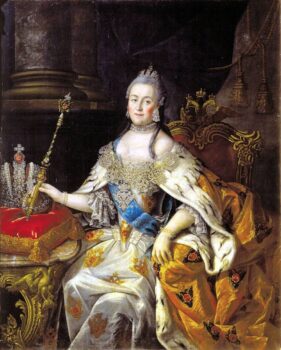Catherine the Great: Scandal, Strategy and Survival
Few rulers in history have commanded as much fascination as Catherine II of Russia, more famously known as Catherine the Great. She was not born Russian, nor was she expected to rule one of the largest empires on Earth, yet through intelligence, determination, and political acumen, she became one of the most significant monarchs of the 18th century. Catherine’s reign was marked by immense achievements: territorial expansion, modernization reforms, and cultural flourishing. Yet, her story is also laced with intrigue, rumors, and controversy, from her coup against her husband to enduring legends about her private life.
To understand Catherine the Great is to walk a tightrope between fact and myth, between her accomplishments as a ruler and the whispers that still cloud her legacy.
Catherine the Great was not born Catherine at all. She entered the world in 1729 in Stettin, Prussia (modern-day Szczecin, Poland), as Sophie Friederike Auguste von Anhalt-Zerbst-Dornburg. She was born into a minor German noble family, far removed from the great powers of Europe. Her father was a Prussian officer; her mother was well-connected in the intricate web of European aristocracy.
From a young age, Sophie displayed sharp intelligence and a formidable will. She devoured books, excelled at languages, and learned the art of charm, qualities that would later serve her well at the Russian court. At just 14, she was summoned to Russia after Empress Elizabeth of Russia selected her as a potential bride for her nephew and heir, Grand Duke Peter of Holstein-Gottorp.
Sophie converted to Eastern Orthodoxy, adopting the name Catherine Alekseyevna, and quickly endeared herself to the Russian people through her charm and dedication to Russian customs. Yet, her marriage to Peter was anything but happy.
Catherine’s marriage to Peter was a personal catastrophe. Peter was immature, erratic, and obsessed with military games. Many accounts suggest he was more interested in his toy soldiers and drinking than in ruling, or in his wife. Their union was loveless, and Catherine found herself isolated in a foreign court, forced to rely on her own wit to survive.
During these years, Catherine threw herself into self-education. She read works of Enlightenment thinkers like Voltaire, Montesquieu, and Diderot. She understood the power of ideas, but also the reality of politics. She became adept at forming alliances and cultivating supporters at court.
The marriage produced a son, Paul, though rumors swirled that Peter was not the father. Some historians suggest Paul may have been fathered by one of Catherine’s lovers, but the truth remains uncertain.
Did Catherine Kill Her Husband?
In 1762, everything changed. Empress Elizabeth died, and Peter ascended the throne as Peter III of Russia. His reign lasted only six months, and it was disastrous. Peter alienated the Russian nobility by favoring Prussia, Russia’s traditional enemy. He neglected Orthodox traditions, introduced unpopular reforms, and publicly humiliated Catherine.
Sensing opportunity, Catherine moved decisively. With the support of the military, the Orthodox Church, and the powerful Guards regiments, she staged a coup d’état. Catherine rallied troops to her cause, rode through the streets of St. Petersburg in uniform, and declared herself ruler. Peter, abandoned and powerless, was forced to abdicate.
Within days, Peter was dead. Officially, he died of “hemorrhoidal colic” at Ropsha, a secluded estate. In reality, he was murdered, likely strangled by Catherine’s allies, including her lover, Grigory Orlov. Did Catherine order the killing? Historians remain divided. Some argue she knew and approved; others suggest she preferred him alive but conveniently did nothing to stop his death. Either way, Peter’s demise removed the last obstacle to Catherine’s rule.
Thus, a 33-year-old foreign-born woman seized the throne of Russia, not by inheritance but by raw political maneuvering. It was an extraordinary beginning to what would become an extraordinary reign.
Catherine the Great Legacy
Catherine reigned from 1762 to 1796, making her the longest-ruling female monarch in Russian history. Her reign is often described as the Golden Age of the Russian Empire.
1. Expansion of Territory
Catherine pursued aggressive foreign policy. Under her leadership, Russia expanded dramatically, adding Crimea, parts of Poland, and lands along the Black Sea. These conquests gave Russia access to warm-water ports and secured its role as a European great power.
2. Domestic Reforms
Catherine embraced Enlightenment ideals, at least in theory. She corresponded with Voltaire and Diderot, admired Montesquieu, and attempted to modernize Russian laws and governance. She convened a “Legislative Commission” to draft a new legal code, though it ultimately failed due to opposition from the nobility.
She also reformed education, founding schools for girls, and encouraged vaccination against smallpox. She supported the arts, bringing Western culture to Russia, and turned St. Petersburg into a hub of European sophistication.
3. Patron of the Arts
Catherine collected vast amounts of art, laying the foundation for the Hermitage Museum, now one of the world’s greatest art collections. She invited leading intellectuals and artists of the day to her court, eager to position Russia as a center of culture and learning.
The Dark Side of Catherine’s Rule
Yet, Catherine’s reign was not without its shadows. Her reforms often stopped short of true transformation. While she flirted with Enlightenment philosophy, she remained deeply reliant on the nobility for power.
In fact, she expanded the power of the nobility over serfs, tying millions of peasants more tightly into bondage. The plight of the serfs worsened, leading to massive unrest. The most famous was Pugachev’s Rebellion (1773–1775), a brutal peasant uprising that nearly toppled Catherine’s regime. The rebellion was crushed with overwhelming force, leaving tens of thousands dead.
This contradiction, an “Enlightened Despot” who admired Voltaire while presiding over one of Europe’s most repressive serfdom systems, remains one of the great paradoxes of her reign.
Catherine the Great Rumors, Lovers, and Scandal
If Catherine’s political life was remarkable, her personal life became the stuff of legend, and scandal. She had a long line of lovers, often younger men, some of whom she elevated to positions of power and showered with wealth. Her most famous lovers included Grigory Orlov, who helped her seize the throne, and Grigory Potemkin, a brilliant military commander and perhaps the great love of her life.
Catherine’s open sexuality scandalized her contemporaries, especially in a male-dominated world where female rulers were expected to embody virtue. Whispered rumors painted her as insatiable, cruel, and even perverse.
The most infamous rumor, the claim that Catherine died during sexual intercourse with a horse, is pure slander. It was invented by her enemies after her death, reflecting both misogyny and resentment toward her power. In truth, Catherine died in 1796 of a stroke at the age of 67.
Why Was Catherine the Great Controversial?
Catherine remains controversial for several reasons:
Her Seizure of Power – She was not the legitimate heir but took the throne by deposing her husband.
Her Husband’s Death – Whether or not she ordered Peter’s murder, suspicion has never faded.
Her Lovers – Her unapologetic sexual life shocked European courts and gave rise to endless gossip.
Her Contradictions – She championed Enlightenment ideals but upheld serfdom, expanded noble privilege, and ruled as an autocrat.
These contradictions make her a figure who can be seen as both progressive and regressive, enlightened and ruthless.
Was Catherine the Great a Hero?
The question of whether Catherine was a hero depends on perspective.
As a stateswoman, she expanded Russia’s borders, strengthened its military, and placed it firmly among the great powers of Europe. She founded institutions, encouraged the arts, and engaged with Enlightenment thought. For these achievements, many consider her one of the most successful monarchs in Russian history.
As a reformer, her record is mixed. She introduced some modernization but failed to address the most pressing injustice of Russian society, serfdom. Her unwillingness (or inability) to dismantle this system condemned millions to continued suffering.
As a woman, she broke barriers. Few women of her time ruled with such independence and authority. She defied expectations, asserting her right not only to rule but to enjoy power and passion on her own terms.
As a person, she was both admired and reviled. Her intelligence, ambition, and energy made her legendary, but her scandals and contradictions ensured she was never universally adored.
Catherine’s Enduring Legacy
When Catherine died in 1796, she left behind an empire larger and stronger than when she found it. Russia was richer, more powerful, and more culturally vibrant. Yet the seeds of future turmoil, serfdom, inequality, and autocracy, remained firmly planted.
Catherine the Great remains one of history’s most captivating rulers precisely because she cannot be easily categorized. She was both an Enlightenment monarch and an absolute autocrat, a reformer and a reactionary, a passionate woman and a cold strategist.
Her story is not merely one of power, but of how myths, gossip, and gendered expectations can shape the memory of a ruler. While many kings took lovers, few were so vilified for it. While many monarchs rose to power through violence, few were so accused of personal involvement in murder.
In the end, Catherine the Great was not just a ruler of Russia, she became a symbol of ambition, resilience, and controversy. Her life reminds us that history is as much about the stories we tell as it is about the facts themselves.




